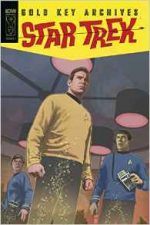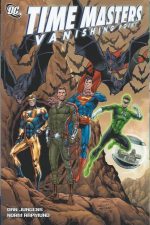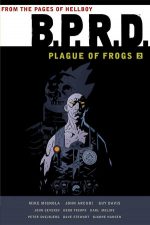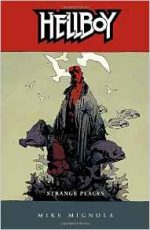
By Roy Thomas, Chris Claremont, Doug Moench, Tony Isabella, Gil Kane, Larry Hama, John Byrne & various (Marvel)
ISBN: 978-0-7851-9164-3
Comicbooks have always operated within the larger bounds of popular trends and fashions – just look at what got published whenever westerns or science fiction dominated on TV – so when the ancient philosophy and health-&-fitness discipline of Kung Fu made its unstoppable mark on domestic entertainment it wasn’t long before the Chop Sockey kicks and punches found their way en masse onto the four-colour pages of America’s periodicals.
As part of the first Martial Arts bonanza, Marvel converted a forthcoming license to use venerable fictional villain Fu Manchu into a series about his son. The series launched in Special Marvel Edition #15, December 1973 as The Hands of Shang Chi: Master of Kung Fu and by April 1974 (#17) it became his exclusively.
A month later the House of Ideas launched a second oriental-tinged hero in Iron Fist; a character combining the Eastern combat philosophy with high fantasy, magic powers and a proper superhero mask and costume…
The character also owed a hefty debt to Bill Everett’s pioneering golden Age super-hero Amazing Man who graced various Centaur Comics publications between 1939 and 1942. The tribute was paid by Roy Thomas & Gil Kane who adopted and translated the fictive John Aman’s Tibetan origins into something that gibed better with the 1970’s twin zeitgeists of Supernatural Fantasy and Martial Arts Mayhem…
This collection gathers the far-ranging appearances of the Living Weapon from Marvel Premier #15-25, Iron Fist #1-15 and Marvel Team-Up #63-64 (spanning May 1974 to December 1977), which saw the high-kicking wonder uncover his past and rediscover his heritage and humanity before inevitably settling into the inescapable role of costumed crusader as half of superhero and detective bromance Power Man and Iron Fist.
The saga began on a spectacular high in Marvel Premier #15 with ‘The Fury of Iron Fist!’ by Thomas, Kane and inker Dick Giordano as a young masked warrior defeats the cream of a legendary combat elite in a fabled other-dimensional city before returning to Earth.
Ten years previously little Daniel Rand had watched as his father and mother died at the hands of Harold Meachum whilst the party risked Himalayan snows to find the legendary city of K’un Lun.
Little Danny had travelled with his wealthy parents and business partner Meachum in search of the fabled city – which only appeared on Earth for one day every ten years. Wendell Rand had some unsuspected connection to the fabled Shangri La but was killed before they found it, and Danny’s mother had sacrificed herself to save the child from wolves and her murderous pursuer.
As he wandered alone in the wilderness, the city found Danny. The boy spent the next decade training: mastering all forms of martial arts in the militaristic, oriental, feudal paradise and enduring arcane ordeals, living only for the day he would return to Earth and avenge his parents…
After conquering all comers and refusing immortality, Iron Fist returned to Earth a Living Weapon able to turn his force of will into a devastating super-punch…
From the outset the feature was plagued by an inability to keep a stable creative team, although, to be fair, story quality never suffered, only plot and direction. Reaching New York City in #16, ‘Heart of the Dragon!’ by Len Wein, Larry Hama & Giordano found Iron Fist reliving the years of toil which had culminated in a trial by combat with mystic dragon Shou-Lao the Undying, winning him the power to concentrate his fist “like unto a thing of Iron†and other unspecified abilities. The epic clash permanently branded his chest with the seared silhouette of the fearsome wyrm.
His recollections are shattered when martial arts bounty hunter Scythe attacks, revealing that Meachum knew the boy was back and had put a price on his head…
Danny had not only sacrificed immortality for vengeance but also prestige and privilege. As he left K’un Lun, supreme ruler of the city Yü Ti, the August Personage in Jade, had revealed that murdered Wendell Rand had been his brother…
Marvel Premier #17 saw Doug Moench take over scripting as Iron Fist stormed Meachum’s skyscraper headquarters; a ‘Citadel on the Edge of Vengeance’ converted into a colossal 30-storey death trap, leading to a duel with a cybernetically-augmented giant dubbed Triple-Iron and a climactic confrontation with his parents’ killer in #18’s ‘Lair of Shattered Vengeance!’
The years had not been kind to Meachum. He’d lost his legs to frostbite returning from the high peaks, and, hearing from Sherpas that a boy had been taken into K’un Lun, the murderer had spent the intervening decade awaiting in dread his victims’ avenger…
Filled with loathing, frustration and pity, Iron Fist turns away from his intended retribution, but Meachum dies anyway, slain by a mysterious Ninja as the deranged multi-millionaire attempts to shoot Danny in the back…
In #19 Joy Meachum and her ruthless uncle Ward – convinced Iron Fist had killed the crippled Harold – steps up the hunt for Iron Fist via legal and illegal means, whilst the shell-shocked Living Weapon aimlessly wanders the strange streets of Manhattan. Adopted by the enigmatic Colleen Wing Danny meets her father, an aging professor of Oriental Studies who has fallen foul of a ‘Death Cult!’
In his travels the aged savant had acquired ancient text The Book of Many Things, which, amongst other things, held the secret of K’un Lun’s destruction. The deadly disciples of Kara-Kai are determined to possess it. After thwarting another murder attempt Iron Fist tries to make peace with Joy, but instead walks into an ambush with the bloodthirsty ninja again intervening and slaughtering the ambushers…
A period of often painful inconsistency began as Tony Isabella, Arvell Jones & Dan Green took over with #20. The Kara-Kai cultists renew their attacks on the Wings whilst Ward Meachum hires a veritable army of killers to destroy the Living Weapon in ‘Batroc and other Assassins’ – with the identity of the ninja apparently revealed here as the elderly scholar…
Marvel Premier #21 introduced the ‘Daughters of the Death Goddess’ (inked by Vince Colletta) as the Wings are abducted by the cultists and bionic ex-cop Misty Knight debuts, first as foe but soon as an ally. When Danny tracks down the cult he discovers some shocking truths – as does the ninja, who had been imprisoned within the ancient book by the August Personage in Jade in ages past and recently possessed Professor Wing in search of escape and vengeance…
All was revealed and the hero exonerated in #22’s ‘Death is a Ninja’ (inked by “A. Bradfordâ€) with the ninja disclosing how, as disciple to sublime wizard Master Khan, he had attempted to conquer K’un Lun and been imprisoned within the crumbling tome for his pains.
Over the years he had discovered a temporary escape and subsequently manipulated the Wing and Iron Fist to secure his permanent release and the doom of his jailers. Now exposed, he faces the Living Weapon in a final cataclysmic clash…
A measure of stability began with #23 as Chris Claremont, Pat Broderick & Bob McLeod took the series in a new direction. With his life’s work over and nearly nine years until he could go “homeâ€, Danny was now a man without purpose… until whilst strolling with Colleen he stumbles into a spree shooting in ‘The Name is… Warhawk.’
When the cyborg-assassin has a Vietnam flashback and begins heedlessly sniping in Central Park, the Pride of K’un Lun instantly responds to the threat… and thus began his career as a hero…
In ‘Summerkill’ (inked by Colletta) the itinerant exile battles alien robot the Monstroid and opens a long and complicated association with Princess Azir of Halwan, with the mysterious Master Khan resurfacing, apparently intent on killing her and seizing her country…
Marvel Premier #25 was the last of the hero’s run and the start of his short but sweet Golden Age as John Byrne became regular penciller for ‘Morning of the Mindstorm!’ (inked by Al McWilliams). Whilst Colleen is driven to unconsciousness and abducted – and her father driven to the edge of insanity – by mind-bending terrorist Angar the Screamer, Danny, made of far sterner stuff, overcomes the psychic assaults and tracks the attackers to Stark Industries and into his own series…
Iron Fist #1 (November 1975) featured ‘A Duel of Iron!’ as he is tricked into battling Iron Man, even as Colleen escapes and runs into Danny’s future nemesis Steel Serpent before being recaptured and renditioned to Halwan…
After a spectacular, inconclusive and ultimately pointless battle, Danny and Misty Knight also head for Halwan in ‘Valley of the Damned!’ (#2, inked by Frank Chiaramonte) with our hero recalling a painful episode from his youth wherein his best friends Conal and Miranda chose certain death beyond the walls of regimented K’un Lun rather than remain in the lost city where they could not love each other…
As Master Khan begins to break Colleen, Danny and Misty stopover in England where a nuclear horror named The Ravager slaughters innocents by blowing up London Airport and the Post Office Tower (we rebuilt it as the BT Tower, so don’t panic), compelling Iron Fist to punch way above his weight in ‘The City’s Not For Burning!’
Inevitably it ends in ‘Holocaust!’ as Ravager is unmasked as old villain Radion the Atomic Man. He fatally irradiates Danny until the wounded warrior fortuitously discovers the cleansing and curative power of the Iron Fist and storms to his greatest triumph yet…
With Misty recuperating, Danny gets involved with a guilt-ridden IRA bomber named Alan Cavenaugh before tackling another of Khan’s assassins in ‘When Slays the Scimitar!’ after which Iron Fist and Misty finally infiltrate Halwan in #6, courtesy of crusading lawyer Jeryn Hogarth who also promises to secure Danny’s inheritance and interests from the Rand-Meachum Corporation.
The Pride of K’un Lun doesn’t much care since the successfully brainwashed Colleen had been unleashed by Khan, determined to kill her rescuers in ‘Death Match!’…
None of the earthly participants are aware that, from a hidden dimension, Yü Ti is observing the proceedings with cold calculation…
By using his mystic Iron Fist to psychically link with Colleen, Danny breaks Khan’s conditioning and at last the malignant mage personally enters the fray in #7’s ‘Iron Fist Must Die!’: a blistering battle which breaches the dimensions and exposes the August Personage in Jade’s involvement in Wendell Rand’s death.
Given the choice between abandoning his friends on Earth or returning to K’un Lun for answers and justice, the Living Weapon made a true hero’s choice…
With Iron Fist #8 Danny returns to New York and attempts to pick up the pieces of a life interrupted for more than a decade. Unaware that Steel Serpent now works for Joy Meachum, Danny joins the company until merciless mob boss Chaka and his Chinatown gangs attack the business ‘Like Tigers in the Night!’ (inked by Dan Adkins), and Iron Fist is fatally poisoned.
Sportingly offered an antidote if he survives a gauntlet of Chaka’s warriors, Danny triumphs in his own manner when ‘The Dragon Dies at Dawn!’ (Chiaramonte inks) but when a hidden killer bludgeons Chaka, Danny is once again a fugitive from the cops and dubbed the ‘Kung Fu Killer!’ (Adkins) until he, Colleen and Misty expose the entire plot as a fabrication of the gangster.
In #11 ‘A Fine Day’s Dawn!’ the Living Weapon squares off against the Asgardian-empowered Wrecking Crew and, with Misty a hostage, is compelled to fight Captain America in #12’s ‘Assault on Avengers’ Mansion!’ until the Pride of K’un Lun and the Sentinel of Liberty unite and turn the tables on the grotesque god-powered gangsters…
In the intervening time Cavenaugh arrives in New York, but has not escaped the reach of his former Republican comrades. They hire hitman Boomerang to kill the defector and ‘Target: Iron Fist!’ with little success, whereas the villain introduced in issue #14 comes a lot closer: even eventually eclipsing Iron Fist in popularity…
‘Snowfire’ – inked by Dan Green – finds Danny and Colleen running for their lives in arctic conditions when a retreat at Hogarth’s palatial Canadian Rockies estate is invaded by deadly mercenary Sabre-tooth. It just wasn’t their week as, only days before, a mystery assailant had ambushed Iron Fist and impossibly drained off a significant portion of the lad’s Shou-Lao fuelled life-force…
Despite being rendered temporarily blind, the K’un Lun Kid ultimately defeats Sabre-tooth, but the fiercely feral mutant would return again and again…
With Claremont & Byrne increasingly absorbed by their stellar collaboration on the revived and resurgent adventures of Marvel’s mutant horde, Iron Fist #15 (September 1977) was their last Martial Arts mash-up for a while. The series ended in spectacular fashion as – through a comedy of errors – Danny stumbles into battling Wolverine, Colossus, Nightcrawler, Banshee, Storm and Phoenix in ‘Enter, the X-Men’.
The cancellation was clearly not planned however as two major subplots went unresolved: Misty had disappeared on an undercover assignment to investigate European gang-boss John Bushmaster and Danny again had his chi siphoned off by Steel Serpent…
Fans didn’t have to wait long: Claremont & Byrne had already begun a stint on Marvel Team-Up and turned the Spider-Man vehicle into their own personal clearing house for unresolved plot-lines.
MTU #63-64 (November & December 1977 and inked by Dave Hunt) revealed the secret of K’un Lun exile Davos in ‘Night of the Dragon’ as Steel Serpent sucked the power of the Iron Fist from Danny, leaving him near death. Risking all she had gained, Misty broke cover and rushed to his aid…
With the Wall-crawler and Colleen (the girls using the team name “Daughters of the Dragonâ€) to bolster him, Iron Fist defeated Davos and reclaimed his heritage in ‘If Death be my Destiny…’ before shuffling off into a quiet retirement and anonymity.
…But not for long – and certainly the subject of further mammoth full-colour paperback Epic Collections to come…
Although suffering a few grim patches, the greater bulk of the Iron Fist saga ranks amongst the most exciting and enjoyable Costumed Dramas of Marvel’s second generation. If you want a good, clean fight comic this is probably one of your better bets, especially if you’re a fan of original artwork as this titanic tome closes with a fabulous selection, shot from Byrne’s inked pages and original pencil character sketches…
© 1974, 1975, 1976, 1977, 2015 Marvel Characters, Inc. All rights reserved.










